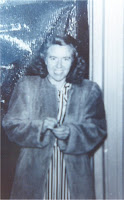
The 4th Great Grandparents of my grandchilden, Ashley and Kolby, are John Coleman Durham and his wife Rachel Black. They were married in KY on August 5, 1869. Rachel was born with a birth defect, a club foot. We do not know which foot or how badly turned in this foot was. She was able to walk and to travel, and travel she did - to court to defend herself against her husband's filing for divorce! Divorce was uncommon in the 1800s and would have led to a great deal of gossip, no doubt.
4th GGrandaddy John was a school teacher who had five living children with his wife Rachel in Kentucky. His eyes strayed. They became focused upon his first cousin, Martha Washington Durham, whom he met while teaching in Missouri. John filed for divorce against Rachel and he alleged that she was unfaithful, but nothing about his own wandering eye for Martha.
Back home in Kentucky, Rachel got notified of the divorce and the court date...in Missouri. To fund her trip to Missouri, she sold her cow for train fare. She also gathered letters attesting to her good conduct from the Mt. Calvary Baptist Church. Having no luggage, she packed her clothes, letters, and necessities, placing them in a flour sack for the trip. From the sale of the cow, she received enough money for the trip to Missouri and the trip back, and it was her intention to bring her straying husband back to Kentucky on that return trip. She was extremely gutsy to say the least. With her limited funds, she did not have the monies needed for a room at an inn or for transportation or even food while in Missouri. John knew she was arriving, but he did not come to the train station to meet her. A minister who happened to be at the station helped Rachel by providing shelter and transportation to the courthouse.
John, who had failed to come to the station, also failed to come to the courthouse! No information is known as to whether John got his divorce, but, guess what? I seriously doubt it.
Rachel showed extreme courage in her trip to Missouri. Traveling alone, hard. Traveling with a club foot, likely hard. Traveling with no funds, hard. John abandoning her completely, hard.
When she returned to Casey County, Kentucky, she did get her cow back though. That is a good thing. The milk cow was either bought by her brother Andrew Black or retrieved in some way by him, and returned to her and the children.
So what happened to 4th GGrandaddy John? If John married Martha, he was a bigamist. If he only lived with her, then he could not marry her until after Rachel died in 1913. Did Martha ever really marry John? Don't know so far. She is listed on his death certificate as Martha Durham, but when you are first cousins, you often share the same surname. Martha and John had six or more children together. John died in 1926.
 A side story: John was the son of Kentucky Jim! 5th Great grandaddy! He married Jane Coleman, whose surname has been popular within the family.
A side story: John was the son of Kentucky Jim! 5th Great grandaddy! He married Jane Coleman, whose surname has been popular within the family.James Durham lived in KY but moved to MO to be with other family members in that state around 1850. By 1852 he was back in KY swearing he would never, ever, live in Missouri again. His family affirmed it when they nicknamed him forevermore as Kentucky Jim!
Front Row LtoR: KY Jim, his daughter Mary Magdalene Durham with her son, child Roscoe Durham standing by his mom, Rachel Black Durham, child Dewitt Raney, father Proctor Raney with Aurora Durham Raney who has her hand placed on her husband's shoulder on the right side of the photo. Aurora is a daughter of John Coleman and Rachel Black Durham.
Rear Row LtoR: Arvina Raney daughter of Sally Jane Durham and Joseph K. Raney, James Durham with his arm on shoulder of his brother John S. Durham (sons of Rachel and John Coleman Durham, in widow's black is Mammy (Sally Jane Durham Raney; daughter of Rachel and John Coleman Durham). Note: James Durham Family (KY Jim)" photo courtesy of Regina Baldock's site at Ancestry.com. Thanks!





















